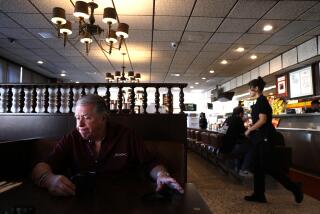Art Dealer Detours From the Fast Lane : Lerner Could End Up in Prison on Drug Charge
For Stanley R. Lerner, a 25-year-old UCLA dropout-turned-entrepreneurial phenom, today could be the day to say goodby to his symbols of success: the fire-engine red Porsche, the champagne fund-raisers, the Beverly Hills office with the black marble and chrome desk, the pricey paintings that hang in his Rodeo Drive gallery.
Today, Lerner is scheduled to appear before U.S. District Court Judge Robert Tagasuki to be sentenced on charges of conspiracy to deal cocaine. The maximum term: 40 years in prison and a $2-million fine.
The sentencing will mark an abrupt passage in the free-wheeling, fast-dealing life of Lerner, whose brief career has included a string of business ventures--from a compact disc store, to a company that tried to market an at-home AIDS test, to his job as president and sole owner of Triangle Galleries of Newport Beach and Beverly Hills.
At his peak, this son of middle-income parents from Montebello spent his days negotiating multimillion dollar art transactions involving some of the world’s best-known painters--Renoir, Degas, Manet. In his depths, he pleaded guilty to the cocaine charges. A month later, he worked as a police informant, producing tips that helped crack a multimillion-dollar international art fraud case.
Some of the people who know him seem baffled by Lerner’s change of fortunes. They find it difficult to imagine that Lerner became mixed up in drug dealing and phony art.
“I can’t match that Stan Lerner,” said one old friend, “with the Stan Lerner that I know.”
“He’s a remarkable young man,” said Brad Lemack, a public relations man who coordinated a celebrity art fund-raiser at Triangle Galleries in February. “I was impressed that he seems to have accomplished so much at such a young age. He’s a baby. I’ve got ties older than that.”
Others see his case as another example of 1980s excess turned sour in 1990. He has plenty of foes delighted at his fall. Said one: “He was looking to make as much money as he could and he played with fire and got caught.”
Charming, with a quick mind and a broad smile, Lerner said he has been humbled in the 18 months since his arrest--in part through a new-found devotion to his religion, Judaism, that takes him to synagogue five times a week.
Lerner’s cooperation with authorities in the art fraud case--he initiated the relationship the month after he pleaded guilty to the cocaine charge--has enabled him to delay his sentencing for nine months. His lawyer is expected to argue today that Lerner deserves credit, in the form of a lighter sentence, for his help.
The information Lerner gave authorities helped them arrest two men he did business with: Lee Sonnier, the former manager of the Rodeo Drive branch of the Upstairs Gallery art chain; and independent art broker Frank De Marigny, who earlier this month pleaded no contest to charges of perjury, grand theft and forgery stemming from the investigation.
The Sonnier and De Marigny cases sent tremors through the world of Beverly Hills arts traders, raising fears that high-priced paintings might be bogus and generally casting a shadow of distrust over the buying and selling of art.
Lerner has not been charged with any crime involving phony art. He was granted immunity--although he said he did not need it--in exchange for the testimony he would have given had De Marigny gone to trial.
Authorities allege that, in addition to other dealings, Sonnier and De Marigny conspired to sell a fake Renoir painting to a Japanese businessman while the original was hanging in the Metropolitan Museum of Art in New York City. De Marigny also was charged with trying to sell the same painting to an undercover officer during a sting operation that Lerner arranged last September.
According to court testimony and other documents, and interviews with his former employees and associates, Lerner acted as a paid broker who helped line up buyers for De Marigny--who supplied the artwork--and Sonnier, who sold it.
Lerner told authorities of six instances in which he bought paintings credited to French Impressionists from De Marigny and sold them to Sonnier. Five of those pieces--along with the phony Renoir--were later purchased by a Japanese businessman who claims the works were either fake or never delivered. Lerner said he did not believe the pieces were fake.
In a civil suit filed against, among others, Lerner, De Marigny and Sonnier, businessman Koichi Akemoto claims he was bilked out of more than $2 million. While Lerner denies the allegation, Akemoto’s lawyers say they have evidence that Sonnier paid Lerner at least $800,000 last summer--money that they believe was in return for Lerner’s help in procuring phony artworks for their client.
While Akemoto’s civil lawyers are trying to recover money from Lerner, defense lawyers for De Marigny and Sonnier have attempted to paint him as a convicted criminal who pinned blame on their clients because it might help him get a lighter sentence on his cocaine charge.
Perry Wander, who represented De Marigny in the early stages of the case, said: “I think it’s a travesty of justice the way they are prosecuting Frank like gangbusters and Stan is out walking around, selling art. I’ve told the D.A., ‘You are prosecuting the wrong guy.’ ”
While prosecutor Reva Goetz, in charge of the art fraud case, declines to discuss the cases, Lerner dismisses such accusations, saying he went to authorities the instant he learned he had sold phony work and that it was only proper for him to do so.
“My actions speak for themselves,” he said.
But others, including the man who was convicted as Lerner’s co-conspirator in the cocaine case, describe him as a tough businessman who fancies himself a high-roller and who, before his arrest, leased a luxurious condominium overlooking Wilshire Boulevard, wore Armani suits, drove Porsches, Mercedeses and a Ferrari, and once displayed a high-powered assault weapon to a friend. They are suspicious of Lerner’s claim that he has undergone religious transformation.
“When you meet him you are going to be charmed out of your mind,” said one business associate. “He’s very charismatic, very intelligent. He’s got this big boy smile and you’re gonna think, ‘How could anyone say anything bad about this guy?’ ”
In two lengthy interviews--one of them over lunch at a Beverly Hills restaurant where he knew all the waiters and the maitre d’--Lerner was personable, witty and seemingly eager to talk. But there were two things he would not discuss on the record: his cocaine conviction and his role in the art fraud investigation.
Describing himself as an “entrepreneur,” Lerner said he established his art business with an initial investment of a few thousand dollars and a bit of help from his friends. “Donald Trump has his art of the deal and I have mine,” he said. “I didn’t have money so I either borrowed it or I was very fortunate. People helped me.”
Those who know Lerner consider his Trump reference apt. They describe him as smart and ambitious, with an ego that knows no bounds.
At Montebello High School, Lerner graduated seventh in a class of 449 students and competed in tennis, water polo and swimming. His teachers recall that he was very bright, but once called his parents in to discuss his insubordination.
“You couldn’t tell the kid anything,” said Tim Murphy, the school’s athletic director and Lerner’s former swim coach. “It was just like he had the world by the tail. He had all the answers.”
Lerner attended UCLA but quit in June, 1985, he said, to help with the family auto parts business when his father became ill.
He became involved in the art world in September, 1986--at the age of 21--when he agreed to pay an art publisher, Robert Bane, $30,000 to produce limited edition reproductions. Court records show the venture fell apart in a legal dispute.
By March, 1987, Lerner was leasing more than 2,200 square feet on the 27th floor of one of the Century City Towers on Century Park East, at a cost of nearly $4,800 a month. His former lawyer and office mate, Joel Spivak, said Lerner was always dabbling in some new endeavor--a computerized clearinghouse for art dealers, an at-home AIDS test and the compact disc store. But, Spivak added, these ventures never seemed to get very far.
By November, 1988, Lerner had moved out of the office tower amid a rent dispute and was in prison at Terminal Island.
He had been arrested by the FBI on allegations that he conspired to distribute five kilograms of cocaine. No one involved in the investigation would elaborate. Because the case was not tried, no details have emerged.
Lerner was released when the charges were dropped for lack of evidence. The indictment was reinstated and he pleaded guilty last August.
Lerner said he started working as an art broker shortly after his release from prison. He founded Triangle Galleries in April, 1989.
He would not say how he became involved with De Marigny and Sonnier. While some say he earned hundreds of thousands of dollars from their sales, he apparently wasn’t paying his bills on time. Former employees said paychecks were often late and suppliers were frequently calling for money.
Paradoxically, this is the same Stan Lerner who now lives with his recently widowed mother in Montebello, who says he gets more enjoyment from praying than from driving his Porsche, who hosts charity fund-raisers, and who once paid a homeless artist to paint in front of his gallery because he felt sorry for him.
The same Stan Lerner who, when asked if he is worried about going to prison, drinks a sip of mineral water at a Rodeo Drive cafe, takes a deep breath and responds:
“The only thing that anyone can expect of themselves is to do the best thing he can do everyday. I feel like if I can continue to do the best that I can do everyday for myself and for other people, then things will work out.”
Times staff writer Alan Citron contributed to this story.
More to Read
The biggest entertainment stories
Get our big stories about Hollywood, film, television, music, arts, culture and more right in your inbox as soon as they publish.
You may occasionally receive promotional content from the Los Angeles Times.










